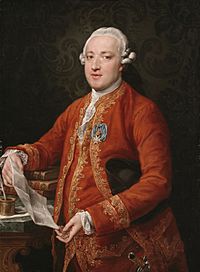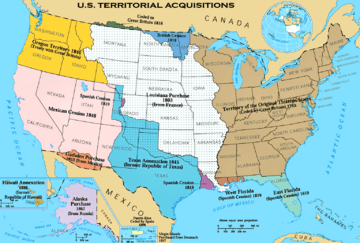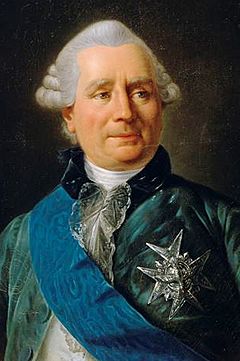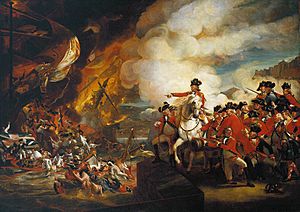Treaty of Aranjuez (1779) facts for kids
| Treaty of Alliance between Spain and France | |
|---|---|

Conde de Floridablanca, Chief Minister of Spain 1777–1792
|
|
| Context | Spain joins the Anglo-French War (1778–1783) |
| Signed | 12 April 1779 |
| Location | Aranjuez, Spain |
| Negotiators | |
| Parties | |
The Treaty of Aranjuez (signed on April 12, 1779) was an important agreement. In this treaty, Spain promised to help France in its war against Great Britain. In return, France agreed to help Spain get back some lands it had lost. These lands included Menorca, Gibraltar, and Spanish Florida.
Even though Spain did not officially join the American Revolutionary War, it helped the American colonists. Spain allowed supplies to be sent through Louisiana. This helped the Americans avoid the British navy's blockade. Also, Spain's recapture of Florida stopped the British navy from using bases along the Gulf Coast. Outside of North America, Spain got Menorca back. However, it failed to capture Gibraltar, even after spending a lot of money and effort.
After the war, in 1783, new treaties were signed. These treaties mostly returned things to how they were before the war. The only exceptions were Menorca and Florida, which Spain kept.
Contents
Why Spain Joined the War
Spain had lost Menorca and Gibraltar to Britain in 1713. This happened because of the Treaty of Utrecht. Getting these lands back was a main goal for Spain.
Past Conflicts and Land Changes
During the Seven Years' War in 1756, Spain was allied with France. Spain managed to recapture Menorca. However, it lost Havana and Manila in 1762. When that war ended with the Treaty of Paris (1763), Britain traded Havana and Manila for Spanish Florida. France then gave Louisiana to Spain as a way to make up for this.
British West Florida was a very important area. It controlled the entrance to the Mississippi River through the port of Mobile. It also included the modern Gulf Coast of the United States.

Spain's Early Support for America
When the American Revolutionary War began in 1776, Britain blocked many ports. This made Spanish ports like New Orleans and Havana very important. They became vital routes for sending supplies to the American colonists.
Spain's Chief Minister, Count Floridablanca, wanted to get Menorca, Gibraltar, and the Floridas back through talks. He also wanted Britain to remove its illegal settlements in Central America. Peace with Britain was important for his plans to improve Spain. He was also worried about Spain's colonies in the Americas, called New Spain, because they were open to attack by the British navy.
Spain also had arguments with Britain's ally, Portugal, over land near the Rio de la Plata. Spain and Portugal fought some small wars over this. Unlike earlier fights, Britain could not help Portugal because it was busy elsewhere. So, Portugal stayed neutral during the American Revolutionary War.
The Spanish–Portuguese War (1776–77) ended with the First Treaty of San Ildefonso in October 1777. Then, in the Treaty of El Pardo (1778), Portugal agreed not to let its ports in the Americas be used by nations fighting Spain. This rule was aimed at Britain.
France and Spain Join Forces
In February 1778, France and the United States signed a Treaty of Alliance. In this treaty, France recognized the United States as an independent country and offered military help. This made the American War a bigger, global conflict. It also made it harder to find a peaceful solution with Britain.
Because of this, on April 12, 1779, France and Spain signed the Treaty of Aranjuez. Spain officially declared war on Britain on June 21.
What the Treaty Said
Spain agreed to support France's demands for certain trade benefits. France wanted to undo some of Britain's gains from the Treaty of Utrecht in 1713. Many parts of the treaty were kept secret. For example, France was given special control over the Newfoundland fishing grounds. This was something the Americans would not have liked.
In return, France would help Spain get back Gibraltar, Menorca, and Florida. However, Spain would only attack British lands outside the United States. Spain also did not recognize the United States as an independent country until the Peace of Paris in 1783.
Spain's Concerns About the American Revolution
One reason Spain was careful about getting involved directly was that King Charles III and Floridablanca were worried. They feared that the American Revolution might inspire Spain's own colonies to seek independence. Spain saw its colonies as very important for its economy.
Also, before the war, there had been ongoing arguments about American colonists moving into New Spain. Spain believed that once the United States replaced Britain, future conflicts would be unavoidable.
Another effect of the Treaty was that it made the American Congress deeply distrustful of "foreign agreements." This feeling still exists today. France secretly agreed to keep fighting until Spain got Gibraltar back. At the same time, the 1778 treaty between France and America said they would not make a separate peace. This meant that American independence was tied to Spain getting Gibraltar back, and the American Congress did not even know about it.
After the Treaty
In February 1782, Menorca was captured by a combined French and Spanish fleet. Spain also captured the Floridas. These were big successes for Spain.
However, Spain put its biggest effort into the Great Siege of Gibraltar. After three years, the siege had made little progress. It cost a huge amount of money and men. To pay for the war, heavy taxes and "voluntary" donations were collected. This caused unrest in many parts of the Spanish Empire. For example, the Revolt of the Comuneros happened in New Granada in 1781. In the end, the siege of Gibraltar used up British resources that could have been used in America. But Spain had little to show for its efforts.
End of the War
When Yorktown surrendered in October 1781, Britain accepted defeat in North America. However, Britain caused heavy losses to the French fleet at the Battle of the Saintes in April 1782. This greatly affected France's ability and desire to continue the war. So, France began talking with Britain about a peace settlement.
Spain insisted on continuing the war until Gibraltar fell, as the Treaty stated. But Spain dropped this demand after a terrible attack by combined French and Spanish forces failed in September 1782.
Spain and France wanted to create a United States that would depend on them for help against Britain. This would help them reverse the losses they had suffered in 1763. To do this, they tried to make a deal with Britain that would leave out the Americans. France suggested that the western border of the US should be along the Appalachian Mountains. This would match the British 1763 Proclamation Line. Spain suggested giving up more land in the important Mississippi River Basin. They also suggested giving up Georgia, which went against their alliance with France and America.
Britain wanted to make the US strong enough to stop France from gaining power in North America again. So, Britain was not interested in these ideas. The disagreements among their enemies allowed Britain to talk separately with each country. This helped Britain improve its overall position. Britain agreed to early terms with the United States in September 1782. This left France and Spain isolated.
Britain's success in relieving Gibraltar in February 1783 made its position stronger. It also weakened Spain's determination. This led to the 1783 treaties with France and Spain. With the exception of Menorca and Florida, these treaties mostly returned things to how they were before the war.
See also
 In Spanish: Tratado de Aranjuez (1779) para niños
In Spanish: Tratado de Aranjuez (1779) para niños



